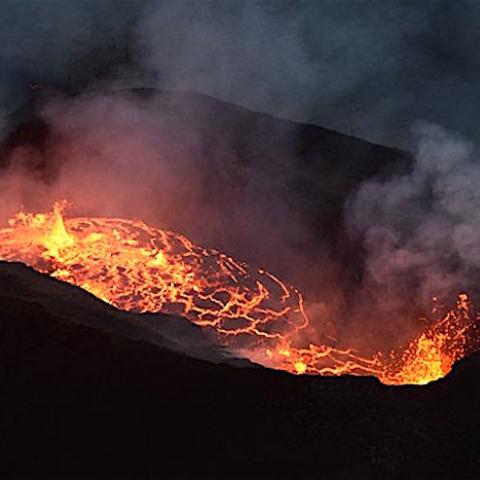
The middle East Rift Zone eruption at Hawai'i Volcanoes National Park was slow moving/USGS
A slow-moving smoldering eruption of Kīlauea volcano inside Hawai'i Volcanoes National Park continued in a remote area of the park Tuesday morning.
The eruption, which has been sporadic, began this past weekend near the Makaopuhi Crater in the park's East Rift Wilderness on the east side of the Chain of Craters Road that runs from park headquarters to the southern coast of the Big Island. While the eruption briefly picked up activity before dawn Tuesday, the U.S. Geological Survey's Hawaiian Volcano Observatory reported that the event posed no threat to humans or infrastructure.
"All current and recent activity is within Hawaiʻi Volcanoes National Park. No changes have been detected in the lower East Rift Zone or Southwest Rift Zone," the observatory reported.
A distant view of the eruption can be seen from this USGS webcam.

Unlike many of the eruptions from Kīlaeau's Halemaʻumaʻu crater, the current eruption is not rocketing lava into the sky nor releasing long racing tendrils of bright red lava downhill. Rather, it is producing lava in more of an oozing fashion and releasing high levels of volcanic gases —primarily water vapor and sulfur dioxide — the observatory said.
"Hawaiian lava flows generally advance slowly downslope and can be avoided by people. They can destroy everything in their paths including vegetation and infrastructure—which can cut off road access and utilities," the agency said. " Hazards associated with active or recent lava flows include hot and glassy (sharp) surfaces that can cause serious burns, abrasions, and lacerations upon contact with unprotected or exposed skin; uneven and rough terrain can lead to falls and other injuries; hot temperatures that can cause heat exhaustion or dehydration, or in heavy rain can produce steamy ground-fog that can be acidic, severely limiting visibility and sometimes causing difficulty breathing."
The current eruption, within the middle East Rift Zone, is within an area with a long history of volcanic eruptions.
"Pit craters and lava flows are evidence of a long history of magma moving along this rift zone pathway," the observatory noted. "Numerous eruptions took place in this region during the 1960s–1970s. Most eruptions in this area during that timeframe lasted less than one day to about two weeks, though there were long-lived eruptions at Maunaulu (1969–1971 and 1972–1974) and Puʻuʻōʻō (1983–2018). The most recent eruption in this area took place over 35 years at and near the Puʻuʻōʻō vent."
The current eruption has opened a fissure about 1,600 feet long and spewed less than 5 million gallons of lava, according to the observatory. The longest flow of lava so far ran about 300 feet, it added.

This map points out the approximate location of the current volcanic eruption in Hawai'i Volcanoes National Park




 Support Essential Coverage of Essential Places
Support Essential Coverage of Essential Places







Add comment